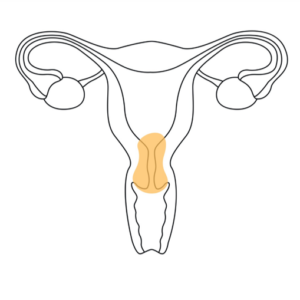
cervical cancer
 Cervical cancer, also known as cervical carcinoma, is the fourth most common cancer among women worldwide. In Germany, approximately 4,400 women are affected each year. Cervical carcinoma is almost exclusively caused by human papillomavirus (HPV). However, it can take years or even decades from infection with HPV to the development of cervical cancer. Therefore, the typical age of onset is between 40 and 59 years.
Cervical cancer, also known as cervical carcinoma, is the fourth most common cancer among women worldwide. In Germany, approximately 4,400 women are affected each year. Cervical carcinoma is almost exclusively caused by human papillomavirus (HPV). However, it can take years or even decades from infection with HPV to the development of cervical cancer. Therefore, the typical age of onset is between 40 and 59 years.
Since the cervix—where cervical cancer often develops—is clearly visible during examinations, the cancer can often be detected early and treated successfully. Not least for this reason, cervical cancer has a good prognosis for cure.
In most cases, cervical cancer is caused by a long-term infection with certain HPV viruses. These viruses are transmitted through direct skin or mucous membrane contact. There are different types of viruses. Some of them are considered “high-risk viruses” and are the main factor in the development of cervical cancer.
However, most women do not need to worry about HPV infection. In most cases, the infection clears up on its own, and even with a persistent infection, cancer rarely develops. Why some women develop cancer and others do not is still unclear. Other factors that contribute to precancerous lesions or cervical cancer include smoking and a weakened immune system, which can be caused by HIV infection or certain medications that suppress the immune system. Unlike breast cancer, hereditary predisposition does not play a major role here.
In its early stages, cervical cancer usually causes no symptoms, so there are no reliable signs. Often, nonspecific symptoms such as general fatigue, unexplained weight loss, abdominal pain, or irregular bleeding occur as the disease progresses.
However, please note: Although these symptoms may be indicative of cervical cancer, they can also have completely different causes!
The following signs may indicate cervical cancer:
- Unusual bleeding, for example after menopause, outside of menstruation, or after sexual intercourse.
- Menstrual bleeding that lasts longer than seven days.
- Foul-smelling vaginal discharge.
- Flesh-colored vaginal discharge.
- Pain in the lower abdomen or pelvis.
- Pain during bowel movements or urination.
- Unusual swelling.
- Pain in the sides or back if urine has accumulated in the kidneys.
See your gynecologist if you experience these or similar symptoms. Your doctor will first perform a gynecological examination and take a Pap smear. This involves removing cells from the cervix and examining them for signs of cancerous changes. In some cases, a colposcopy may also be performed to examine the cervix more closely. If the doctor finds any suspicious changes, a biopsy can provide clarity. This involves taking tissue samples and examining them in the laboratory.
In general, the earlier a pathological change in the cervix is detected, the better the chances of recovery!
If you have been diagnosed with cervical cancer, your doctors will discuss the treatment options with you. The treatment depends on the stage of the disease. In the early stages, surgery may be performed. Either the affected tissue is removed from the cervix in a cone-shaped incision, or the uterus is completely removed. If the cancer is more advanced, additional radiation therapy or chemotherapy, or a combination of both, may be used. The choice of treatment depends on individual factors and will be discussed with your doctor.
Research into the treatment of cervical cancer has made significant progress in recent years. Some of the most promising developments include:
- Checkpoint inhibitors have achieved remarkable results in the treatment of various types of cancer. Current studies are investigating the use of immunotherapy in advanced cervical cancer. By strengthening the immune system, the body’s own defenses against cancer are activated and reinforced.
- Targeted therapies: Advances in molecular diagnostics have led to the identification of certain genetic changes and signaling pathways that play a role in cervical cancer. These findings open up possibilities for targeted therapies that target specific molecular changes and attack the tumor in a targeted manner.
- Radiation therapy technologies: New technologies in radiation therapy, such as intensity-modulated radiation therapy (IMRT) and image-guided radiation therapy (IGRT), enable more precise irradiation of the tumor and protection of the surrounding healthy tissue. This leads to better local control of the tumor and a reduction in side effects.
- Combination therapies: Studies show that combining different treatment modalities such as chemotherapy and radiation therapy can improve the effectiveness of treatment. The combination of chemotherapy and immunotherapy is also currently being investigated and shows promising results.
- Precision medicine and personalized therapy: By characterizing the tumor at the molecular level, treatment approaches can be tailored to the individual. This enables personalized therapy that is tailored to the specific characteristics of the tumor and the patient.
It is important to note that research is constantly evolving and new findings are being made. Clinical trials play a crucial role in evaluating the safety and efficacy of new therapeutic approaches. People affected by cervical cancer should talk to their treating physicians about possible innovative treatment options and participation in clinical trials in order to gain access to the latest developments in treatment.
Did you know?
Early detection: Women aged 20 and over are entitled to a Pap test once a year. This involves taking a cell sample from the cervix, which is then examined in a laboratory for abnormal changes so that precancerous lesions can be detected quickly. Women aged 35 and over can have a combined Pap test and test for certain HP viruses (HPV test) every three years.
Prevention: Cervical cancer is one of the few types of cancer that can be prevented by vaccination against the HP viruses that cause it. However, the vaccination should be given to girls before they become sexually active.
